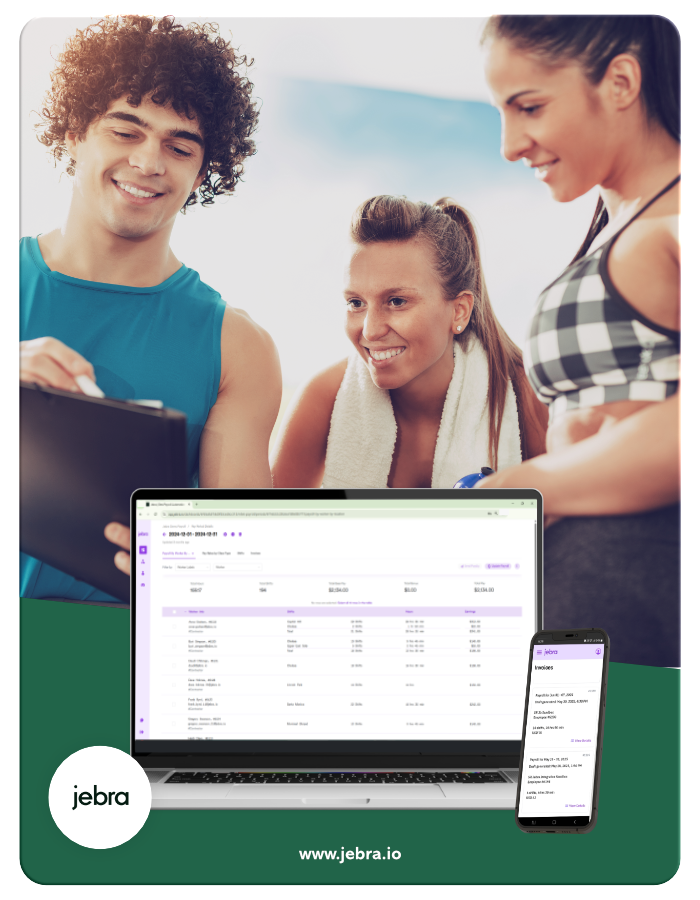
Let your customers know that payroll doesn’t have to be painful.
Payroll and SaaS integrations:
Why they matter and how Jebra helps
The term “integration” gets thrown around a lot when discussing software‑as‑a‑service (SaaS) products. Vendors like to promise that their app will connect with anything, yet the reality is more nuanced. Integration technologies have evolved rapidly, and today even small businesses can build powerful tech stacks without code. When you’re dealing with complex payroll processes—especially for hourly or shift‑based teams—understanding what “integration” really means and how it can improve your operations is essential.
What is a SaaS integration?
At its simplest, a SaaS integration connects one cloud‑based application with another (or with an on‑premises system) so that data can flow automatically between them. Such connections are usually made using application programming interfaces (APIs), which allow one app to request or push data to another. Once connected, information can move in real time or in batches according to predefined rules and triggers. This seamless data flow means your applications can “talk” to each other without manual intervention.
It’s worth unpacking a few terms. App integration is the broadest concept; it covers connecting any two pieces of software—whether cloud‑based or on‑premises—so they can share data. SaaS integration is a subset focused on linking cloud applications like Salesforce or QuickBooks. API integration refers to the actual method of linking systems via code; historically this required heavy developer effort, but modern integration‑platform‑as‑a‑service (iPaaS) tools let non‑technical users build API‑based integrations with little or no code.
Why integrate your payroll stack?
Integrating your payroll tools isn’t just a technical exercise; it can have a significant impact on efficiency, accuracy and employee satisfaction. Here are some of the biggest benefits that credible integration platforms highlight:
- Save time – When data moves automatically between systems, your team doesn’t have to re‑enter hours, pay rates or tax information by hand. This frees staff to focus on higher‑value work.
- Reduce errors and create a single source of truth – Manual data entry is prone to mistakes. Integrations transfer data directly between systems, improving consistency and eliminating conflicting values.
- Increase visibility and transparency – Connected systems mean anyone can access real‑time payroll information without checking multiple apps. This improves decision‑making and speeds up collaboration.
- Improve the employee (and customer) experience – Automated workflows let teams respond faster to queries, process payments sooner and reduce delays, which leads to happier employees and, in customer‑facing contexts, better service.
- Scale efficiently – As your business grows, manual payroll processes become a bottleneck. Integrations enable high volumes of transactions without dramatically increasing headcount.
Despite the upside, there are challenges. Too many disconnected SaaS tools can lead to “SaaS sprawl,” so a holistic integration strategy is important. Integration platforms often require subscription fees and some setup time. Choosing the right tools matters.

Meet Jebra: payroll built for shift work
Jebra is an AI‑powered payroll platform designed specifically for hourly and shift‑based teams. Unlike generic payroll systems, Jebra automates complex calculations—variable pay rates, overtime, overlaps and bonuses—so payroll can be completed in minutes rather than days. The platform is built around seamless integration:
- Integrated reporting – Jebra’s analytics align payroll expenses with revenue and performance, delivering insights tailored for shift‑work. Each payroll period includes an embedded dashboard that shows key metrics, helping businesses track earnings per attendee, attendance rates, cancellation rates and more support.marianatek.com.
- Automated tax withholding and invoicing – Jebra automates tax withholding and filing for employees and simplifies tax filing and invoicing for contractors. Smart invoicing tools reduce errors and ensure compliance with global regulations.
- Employee self‑service – A dedicated employee app gives workers instant, secure access to payslips, breaking down earnings, deductions and payments in an easy‑to‑understand format. Employees can track pay history, manage tax info and stay informed about bonuses or incentives, enhancing financial resilience.
- Historical data archiving- Jebra archives all data in a structured way so that historical data can be retrieved instantly.
Integration at Jebra's core
Jebra’s approach to integration reflects best‑in‑class iPaaS principles. On its integrations page, the company notes that its integrations save managers, finance and operations teams hundreds of hours of manual work. Jebra connects with a broad range of applications across categories such as accounting, HR, time‑tracking and data visualization. Out‑of‑the‑box integrations include popular platforms like Mindbody, Zingfit, Deputy, QuickBooks, Xero, Nmbrs, Paychex and Looker Studio (Google Data Studio), among others. For Mariana Tek users, Jebra offers an integration that automatically imports data, connects to accounting or payroll apps, and requires no ongoing management. The integration also provides tailored dashboards and flags data errors for review, while eliminating hours of error‑prone data entry and reducing administration costs.
Under the hood, Jebra functions as an ETL/Reverse‑ETL automation platform, moving data between systems and back again. On the Xero App Store, Jebra describes itself as an “automation platform that makes enterprise‑level plug‑and‑play automations available to the middle market”. It sends financial reports to Google Data Studio daily, pushes raw data to Google Sheets on demand, automates email invoices and even syncs Zingfit revenues to Xero and Google Sheets. For Mariana Tek users, Jebra offers full‑history data zips synced daily, the ability to post data to PostgreSQL or Google Sheets, and flat CSV exports—illustrating its flexibility as a reverse‑ETL solution. The company invites customers to request custom API integrations, signaling a commitment to expand its integration library.
How does this help payroll teams?
Payroll for shift‑based and gig‑economy workers is notoriously complex. Pay rates vary by role, location, time of day and incentives. Jebra’s dynamic pay‑rate creation and AI‑powered pay‑rate assignment features allow businesses to set unique rates for specific shifts (such as “special ops” or holiday rates) and automatically predict rates based on past preferences. The platform also learns your payroll cadence and replicates the “finish payroll” steps—including payslip delivery and third‑party exports—automatically. When combined with seamless integrations to accounting platforms like Paychex, QuickBooks Payroll, Xero Payroll and Nmbrs, Jebra ensures that payroll data flows into financial systems without manual uploads.
Comprehensive analytics further differentiate Jebra. Its integrated payroll analytics dashboard monitors key performance indicators for each payroll period jebra.io. By threading together scheduling, timesheet and payroll data, businesses can measure employee earnings per attendee, attendance and no‑show rates, cancellation impacts and bonus distributions support.marianatek.com. These insights help studios and gig platforms adjust pricing, staffing and incentive strategies.
Building your tech stack: why pick specialized tools?
Many organizations are tempted by all‑in‑one platforms that promise to handle HR, scheduling and payroll in one place. However, the analogy of a washer‑dryer applies: when one part breaks, you lose both functions. Modern SaaS ecosystems let businesses select “best‑in‑class” tools and connect them via integrations. As integration leaders note, SaaS integration saves time, improves accuracy, increases visibility and scales with your business. Jebra embodies this philosophy: rather than trying to be everything, it focuses on delivering exceptional payroll automation while integrating seamlessly with scheduling, time‑tracking, HR and accounting platforms.
Conclusion
Payroll integration isn’t just a buzzword—it’s a strategic capability that helps businesses operate more efficiently, reduce errors and deliver a better experience for employees and customers. SaaS integrations connect cloud applications via APIs, allowing data to flow automatically across your tech stack. While any integration strategy needs careful planning and may entail some cost and setup time, the benefits of accuracy, transparency, time savings and scalability make it worthwhile.
For organizations with hourly and shift‑based staff, Jebra offers a modern payroll solution built around integrations. Its AI‑powered features automate complex calculations and payroll cycles its integrations connect payroll with scheduling, HR, accounting and analytics tools; and its dashboards provide actionable insights into workforce performance support.marianatek.com. By adopting a specialized platform like Jebra and threading it into a broader SaaS ecosystem, businesses can build a future‑proof tech stack tailored to their unique needs.
Want to learn more?
Book a demo and learn how Jebra saves you hours of work with payroll, reporting and account
